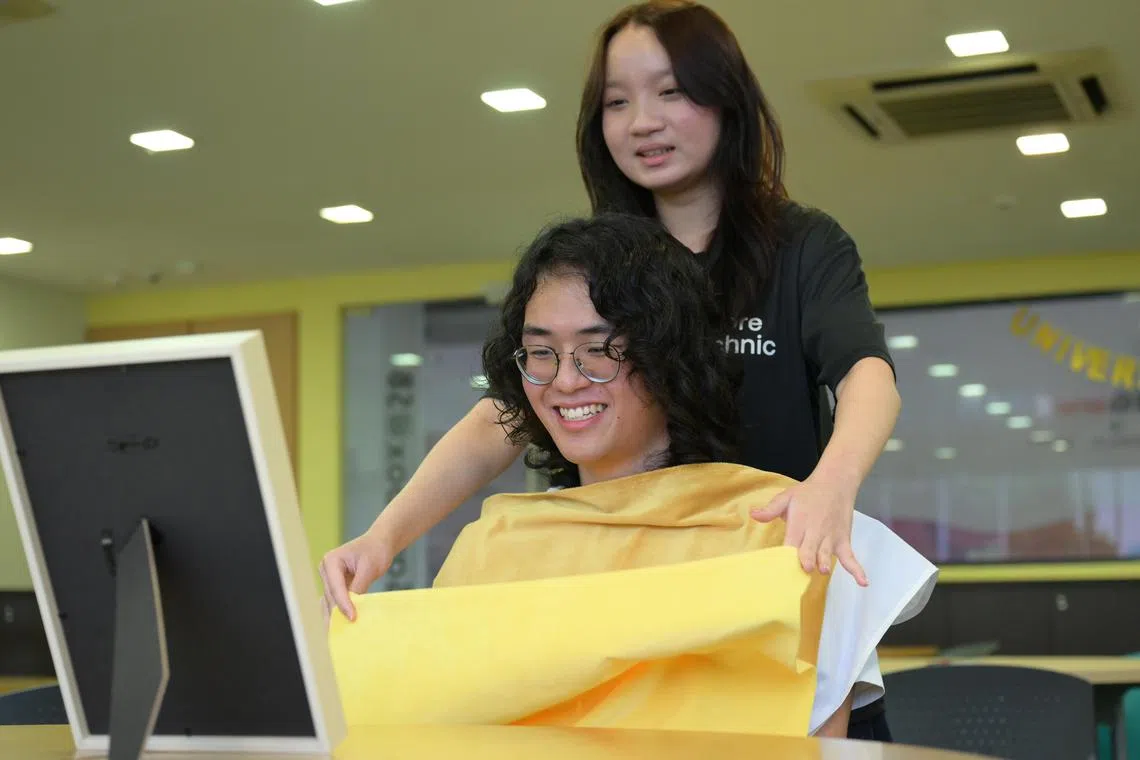Want to know which hues look best on you? Try a colour analysis session
The TL;DR: Want to know what colour clothes to wear? The TLDR team went for a colour analysis session to determine their most suitable shades and find out if the colour analysis trend is worth the hype.
Sign up now: Get ST's newsletters delivered to your inbox

Reporter Dillon Loh getting a colour analysis session with founder of House of Hues, Ong Jing Ting, 19.
ST PHOTO: NG SOR LUAN
Follow topic:
SINGAPORE – Try wearing more warm autumn clothes. That was the advice given to us by the staff at House of Hues at the end of our appointments.
They were not referring to dressing for seasonal weather, however. They meant warmer colours in autumnal hues.
Their advice was the result of a colour analysis session, a personalised service that uses colour theory to help customers identify which colours suit them best.
Colour analysis tests originated in South Korea and, since 2022, the trend has been taking over social media, with 280,000 videos under the hashtag (#coloranalysis) on TikTok, while an armocromia colour analysis filter on TikTok has been used in over 690,000 posts.
But online filters are not the same as in-person sessions. While the rates are high, people would pay the price to get their outfits, make-up and hair colour professionally reviewed.
People from all over the world are travelling to South Korea and forking out $200 per one-hour session. Recently, there has been a rise in similar services offered in Singapore, with prices ranging from $100 to $300.
A full session at House of Hues – a student-run studio that grew out of a polytechnic project – usually lasts 30 minutes, but we each attended a shortened 10-minute version of the programme that went over a reduced range of colours.
We spent the bulk of each session on “colour draping”, a process in which our colour analysts compared different coloured fabrics against our facial features and skin tones to determine which colours would suit us most.
After draping each piece of cloth over our chests, our analysts would ask what we thought of the colour, and then give us in-depth explanations on whether the colour suited us or not.
In the last two to three minutes of our sessions, we went over our event cards, which recorded the results of the colour draping process and which we could take back with us. The cards even had notes detailing reasons why a colour did or did not suit us, just in case we needed to refer to them in the future.
The analysts also categorised us based on our season and tone, which was deemed to be warm autumn based on our darker complexions. This meant that darker colours like brown, dark blue and fern green were more suited to us.
These colour analysis sessions are not just popular among young people. Analysts from House of Hues said that the clientele for their sold-out weekend sessions are generally aged 18 to 40, and are 90 per cent female.
“Most of our male customers are generally family members or boyfriends brought in by female clients,” said Houses of Hues chief executive Ong Jing Ting.
Overall, we were impressed by House of Hues’ colour analysis sessions, especially given that the service costs almost half the going rate at other studios in Singapore. We particularly appreciated the way that the analysts engaged us during the colour draping, including asking for, and sometimes even challenging, our opinions on how we looked with each colour on.
House of Hues usually holds its colour analysis sessions on Saturdays at 25 Lorong Kilat #02-03. You can book a colour analysis session through its Telegram channel
Dillon Loh is a journalist covering the youth beat at The Straits Times.

